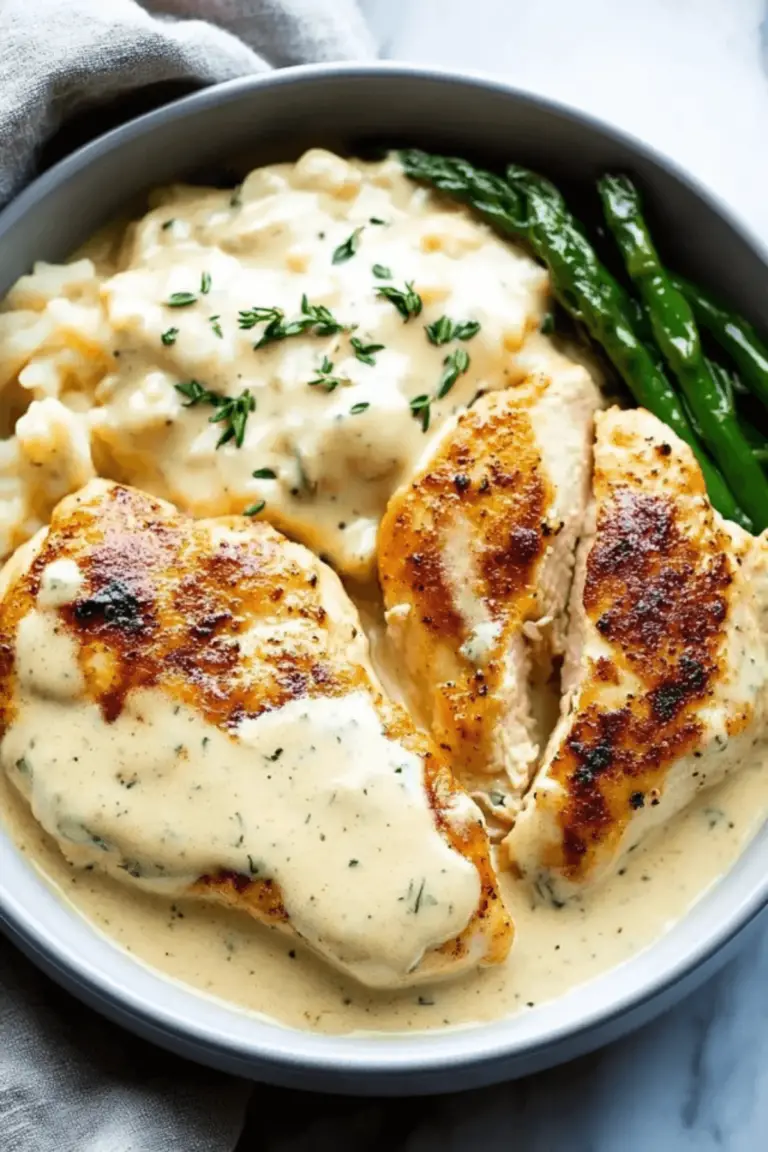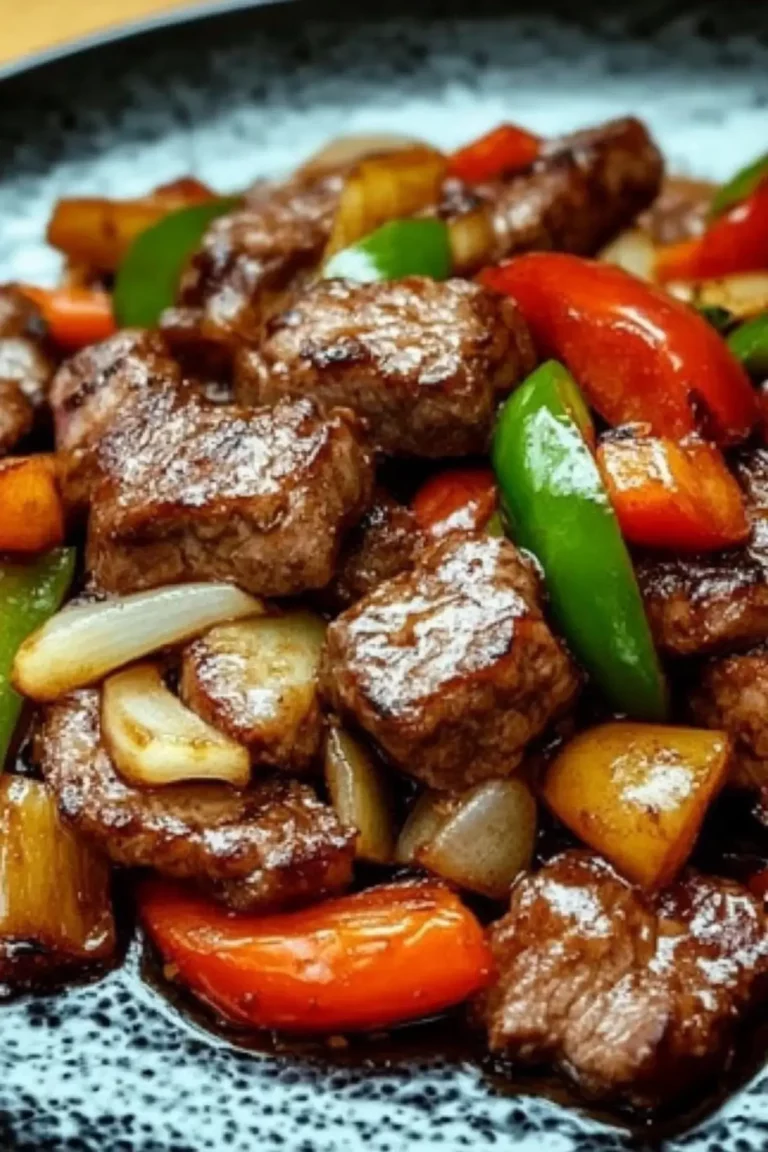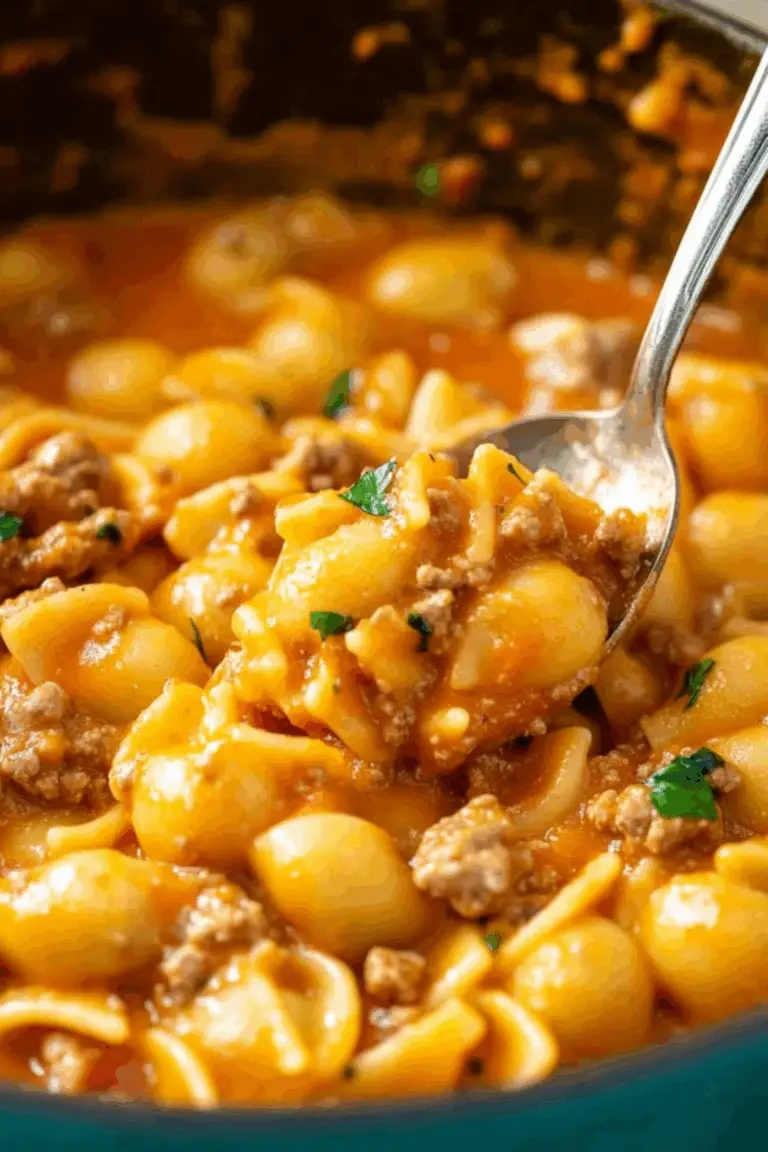The first time I tasted Japanese-style risotto, I was both surprised and delighted. It happened by accident—leftover miso paste, a handful of shiitake mushrooms, and a fillet of salmon that needed to be cooked. I didn’t follow any recipe; I just followed the aroma. What came out was a dish that felt both comforting and elegant—like risotto and a sushi platter had a delicious baby.
This Japanese Style Risotto with Seared Salmon recipe is the perfect meal for beginner cooks looking to create something impressive without the stress. It’s simple, time-efficient, and packed with nutritional benefits thanks to ingredients like salmon, mushrooms, and miso. You’ll only need one pan for the risotto and another for searing the salmon, making clean-up a breeze. Plus, this dish is a well-balanced, protein-rich, and umami-packed option for those seeking quick and healthy meals.
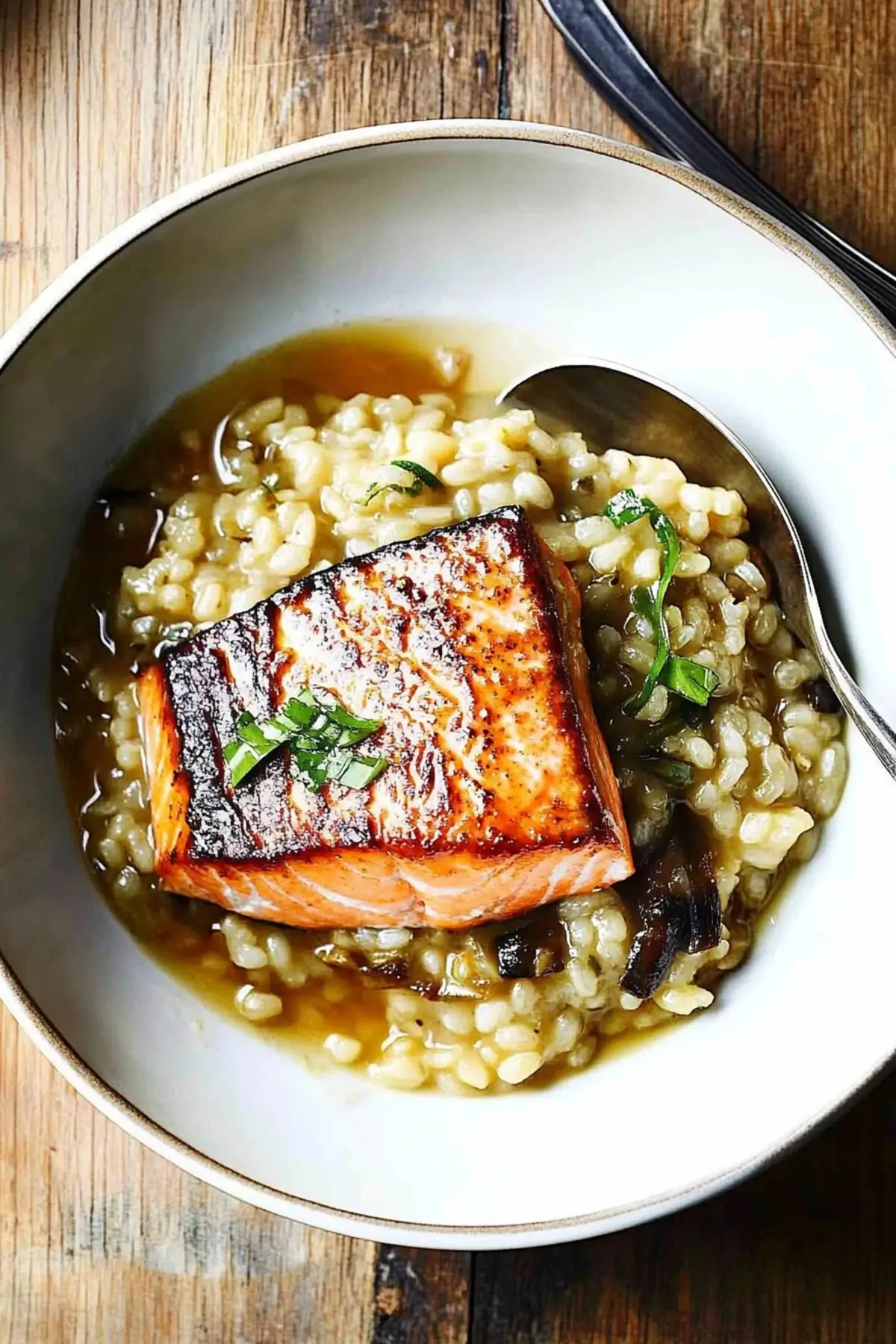
Why This Recipe is Special
This is not your average risotto. The creamy rice gets a Japanese twist with white miso, earthy shiitake mushrooms, and a splash of soy sauce. It’s packed with umami, which is the deeply savory taste found in ingredients like soy, mushrooms, and fermented pastes. The salmon is lightly marinated and seared to form a caramelized glaze that melts into the risotto when served.
This recipe is ideal for:
- Weeknight dinners that feel fancy but are easy to pull off.
- Impressing guests without spending hours in the kitchen.
- Anyone looking for an easy sheet pan dinner alternative with stovetop simplicity.
Ingredients and Preparation
Shiitake Mushrooms
They bring an earthy, slightly smoky flavor and add a meaty texture to the dish. If you don’t have shiitakes, button mushrooms or cremini work well too.
Soy Sauce
Adds saltiness and depth. Use low-sodium to keep things balanced. Tamari is a good gluten-free alternative.
Olive Oil
Used for sautéing, it provides a neutral base for building flavor. You could also use avocado oil or grapeseed oil.
Onion, Garlic, Celery
This trio forms a classic aromatic base that builds a complex flavor foundation. Shallots or leeks can replace onions for a milder taste.
Rice (Sushi or Arborio)
Short-grain rice is essential for creaminess. Arborio, Carnaroli, or sushi rice are best. Avoid long-grain rice—it won’t yield the same creamy consistency.
White Wine
Lends acidity and richness. If you prefer alcohol-free, use sake or simply skip and add more broth with a splash of lemon juice.
Chicken Broth
Infuses the risotto with savory depth. Veggie broth or dashi are great alternatives.
White Miso Paste
The flavor backbone—nutty, sweet, salty, and full of umami. Don’t substitute with red miso; it’s too strong.
Black Pepper, Chives, Sesame Seeds
Final garnishes that add color, aroma, and a hint of spice or crunch.
Salmon Fillets (Skinless or Skin-on)
Go for evenly cut pieces to ensure uniform cooking. If using skin-on, sear skin-side down first.
Butter and Oil
Used together for searing to prevent burning and achieve a flavorful crust.
Marinade (Soy Sauce, Brown Sugar, White Wine)
Creates a lightly sweet, umami glaze on the salmon. Mirin works as a great wine alternative.
Step-by-Step Instructions
Step 1
Start by marinating the salmon in a mixture of soy sauce, white wine, and brown sugar. Coat both sides and let it rest while you prep the risotto. This gives the fish a chance to absorb all the sweet-salty flavor.
Step 2
Tear your shiitake mushrooms into bite-size pieces. Dice the onion and celery, and mince the garlic so they cook evenly and release maximum flavor.
Step 3
In a heavy skillet, heat olive oil over high heat. Sauté the mushrooms until they release moisture, then add a little more oil and cook until browned. Stir in soy sauce, cook another minute, then remove the mushrooms from the skillet.
Step 4
Lower the heat to medium-low. Add more olive oil, then sauté the onion, celery, and garlic for about 2 minutes until fragrant. Stir in the rice and toast for 1 minute until edges look translucent.
Step 5
Pour in the white wine and deglaze the pan by scraping up any brown bits. Let it simmer for 2 minutes.
Step 6
Gradually add warm broth—about 2 ladles at a time—stirring frequently. Wait for each addition to be mostly absorbed before adding the next. This process should take about 15 minutes until the rice is almost tender.
Step 7
Dissolve miso paste in 2 tablespoons of warm broth, then stir it into the risotto with the cooked mushrooms. Simmer for another 5 minutes, adjusting with more broth for desired creaminess.
Step 8
Meanwhile, heat butter and oil in a nonstick skillet. Once hot, add the marinated salmon fillets. Sear for 3–4 minutes on each side until the surface is caramelized and the inside is just cooked through.
Step 9
To serve, spoon the creamy risotto into bowls, top with a piece of seared salmon, and finish with black pepper, chopped chives, and sesame seeds.
Beginner Tips and Notes
- Salmon Sticking to the Pan? Ensure your skillet is properly preheated and oiled before adding fish. Nonstick is your best friend here.
- Too Much Liquid in Risotto? Keep stirring and simmering until it thickens. Risotto should be creamy but not soupy.
- Avoid Mushy Rice by using short-grain types and not overcooking it past al dente.
- Short on Time? Prep veggies and marinate salmon earlier in the day.
- Missing Tools? No ladle? Use a ½ cup measure to add broth in stages. A wooden spoon is ideal for stirring and deglazing.
Serving Suggestions
- Pair with a light cucumber salad or steamed edamame.
- A drizzle of sesame oil or spicy mayo can elevate the flavors.
- Store leftovers in an airtight container for up to 1 day in the fridge. Reheat gently with a splash of broth or water to loosen the risotto.
Conclusion
Now that you’ve walked through this easy sheet pan dinner alternative, you’re ready to make your own lemon herb chicken risotto—or in this case, salmon risotto with a Japanese twist. It’s everything a quick and healthy meal should be: deeply flavorful, beginner-friendly, and endlessly comforting. I’d love to hear how yours turns out—drop a comment below and share your risotto creation. Happy cooking!
FAQ About Japanese Style Risotto with Seared Salmon
Can I use a different type of rice for this risotto?
Yes, while sushi rice and Arborio rice are preferred for their creaminess, you can also use Carnaroli or any other short-grain rice. Avoid long-grain rice, as it won’t yield the same creamy texture.
Is it okay to skip the white wine in the risotto?
Absolutely. You can replace the white wine with sake or leave it out entirely. If omitting, consider adding a splash of lemon juice or extra broth for acidity.
What can I use instead of miso paste?
Miso paste is key to the umami flavor, but if you don’t have it, you can try a small amount of tahini combined with soy sauce as a substitute, though the taste won’t be quite the same.
More Relevant Recipes
Print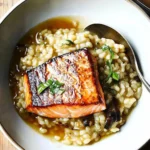
Japanese Style Risotto with Seared Salmon
- Total Time: 40 minutes
- Yield: 4 servings 1x
Description
This Japanese Style Risotto with Seared Salmon is a quick and healthy meal that blends creamy, umami-packed risotto with caramelized soy-glazed salmon for an elegant and comforting dinner. Perfect for busy weeknights or casual entertaining, it’s beginner-friendly and full of satisfying flavor.
Ingredients
For the Risotto:
- 3 tbsp olive oil (divided)
- 10.5 oz shiitake mushrooms (torn into pieces)
- 1 tbsp low sodium soy sauce
- 1 small yellow onion (diced)
- 1 celery stalk (diced)
- 1 garlic clove (minced)
- 1 cup sushi rice or Arborio rice
- ¼ cup dry white wine (or sake)
- 5 cups hot chicken broth
- 1 tbsp white miso paste
- Black pepper (for serving)
- Chives (for garnish)
- Sesame seeds (for garnish)
For the Seared Salmon:
- 5 tbsp low sodium soy sauce
- 1 tbsp dry white wine (or mirin)
- 1 tsp brown sugar
- 4 skinless salmon fillets
- 1 tbsp olive oil
- 1 tbsp unsalted butter
Instructions
- Marinate the Salmon: In a shallow dish, combine soy sauce, white wine, and brown sugar. Coat both sides of the salmon fillets and set them aside while preparing the risotto. Letting the fish marinate enhances its flavor and helps create a beautiful glaze when seared.
- Prepare the Vegetables: Tear the shiitake mushrooms into small pieces, dice the celery, finely chop the onion, and mince the garlic to ensure even cooking and full flavor release during sautéing.
- Sauté the Mushrooms: Heat 1 tablespoon of oil in a heavy-bottomed skillet over high heat. Add the mushrooms and cook until they release their moisture. Add another tablespoon of oil and continue cooking until the mushrooms brown. Stir in soy sauce, cook for one more minute, then remove the mushrooms and set aside.
- Build the Risotto Base: Reduce heat to medium-low and add the remaining tablespoon of oil. Add the onion, celery, and garlic and cook until fragrant, about two minutes. Add the rice and toast for about one minute until the grains begin to look translucent.
- Deglaze and Simmer: Pour in the white wine and stir to deglaze the pan, scraping up any brown bits. Let it simmer for two minutes, then begin adding broth two ladles at a time, stirring often. Wait until most of the liquid is absorbed before adding more. Continue until the rice is almost al dente, about 15 minutes.
- Finish the Risotto: Stir in the reserved mushrooms. Dissolve the miso paste in two tablespoons of hot broth, then add to the risotto. Let everything simmer for another five minutes, adding more broth if needed until creamy.
- Sear the Salmon: While the risotto finishes, heat olive oil and butter in a nonstick skillet over medium-high heat. When the pan is hot, add the marinated salmon. Sear for 3–4 minutes per side until golden brown and the center flakes easily with a fork.
- Serve: Spoon the creamy risotto into bowls, top with the seared salmon, and garnish with black pepper, chopped chives, and sesame seeds.
Notes
- Use a nonstick skillet for salmon to prevent sticking.
- Do not rinse the rice—its starch is essential for creaminess.
If the risotto thickens too much, add a splash of broth to loosen.
Leftovers should be refrigerated and consumed within 24 hours for best texture and taste. - You can make this dish vegetarian by replacing salmon with tofu and using vegetable broth.
- Prep Time: 15 minutes
- Cook Time: 25 minutes
- Category: Dinner
- Method: Stovetop
- Cuisine: Japanese Fusion
Nutrition
- Serving Size: 1 bowl with salmon
- Calories: 627
- Sugar: 3g
- Sodium: 1109mg
- Fat: 29g
- Saturated Fat: 6g
- Unsaturated Fat: 21g
- Trans Fat: 0.1g
- Carbohydrates: 46g
- Fiber: 3g
- Protein: 42g
- Cholesterol: 101mg


